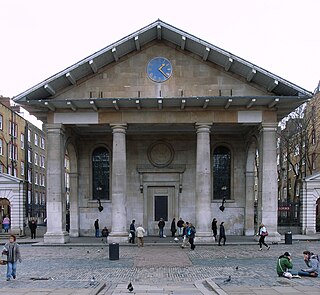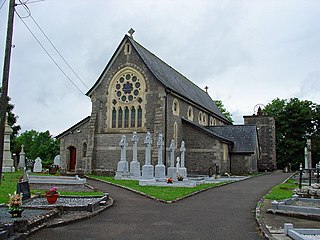Related Research Articles

Saint Patrick's Cathedral in Dublin, Ireland, founded in 1191 as a Roman Catholic cathedral, is currently the national cathedral of the Church of Ireland. Christ Church Cathedral, also a Church of Ireland cathedral in Dublin, is designated as the local cathedral of the Diocese of Dublin and Glendalough.

The Dean of St Patrick's Cathedral is the senior cleric of the Protestant St Patrick's Cathedral, Dublin, elected by the chapter of the cathedral. The office was created in 1219 or 1220, by one of several charters granted to the cathedral by Archbishop Henry de Loundres between 1218 and 1220.
Cradock may refer to:

St Paul's Church is a Church of England parish church located in Bedford Street, Covent Garden, central London. It was designed by Inigo Jones as part of a commission for the 4th Earl of Bedford in 1631 to create "houses and buildings fit for the habitations of Gentlemen and men of ability". As well as being the parish church of Covent Garden, the church has gained the nickname of "the actors' church" by a long association with the theatre community.
Charles Brodrick was a reforming Irish clergyman and Archbishop of Cashel in the Church of Ireland.
Mervyn Archdall was an Irish antiquary and clergyman of the Church of Ireland.
Nicholas Bernard was an Anglican priest and author during the 17th century. A dean in Ireland at the time of the Rebellion of 1641, he wrote descriptions of current events. He was also the biographer of James Ussher.
Timothy Goodwin, Godwin or Godwyn (1670?–1729) was an English churchman, who became archbishop of Cashel.
Denis Maguire, DD, O.F.M., (1721–1798) was an Irish Roman Catholic churchman who served as Bishop of Dromore from 1767 to 1770 and Bishop of Kilmore 1770 to 1798.

Templeport is a civil parish in the barony of Tullyhaw, County Cavan, Ireland. The chief towns in the parish are Bawnboy and Ballymagauran. The large Roman Catholic parish of Templeport containing 42,172 statute acres was split up in the 18th & 19th centuries into three new parishes, Templeport, Corlough and Glangevlin.

Ballymcgovern is a village and townland in County Cavan, Ireland. It lies on the border with County Leitrim, within the parish of Templeport and barony of Tullyhaw on the Ballinamore to Ballyconnell road, the regional R205 road (Ireland).

Edward Parry was Church of Ireland Bishop of Killaloe, County Clare, Ireland from 28 March 1647 until his death 20 July 1650.
The Rt Rev William Knox was Bishop of Killaloe and Kilfenora from 1794 to 1803 when he was translated to Derry.
Cormac Mác Shamhradháin O.S.A., b. c.1410-d.1476, was the Roman Catholic Bishop of Ardagh diocese in Ireland from 1444 to 1476.
Cormac Mág Shamhradháin O.S.A., b. c.1442-d.1511, was the Roman Catholic Bishop of Kilmore diocese, Ireland from 1476 to 1480 and the anti-bishop of Kilmore from 1480 to 1511.

Edmund MacGauran was the Roman Catholic Archbishop of Armagh, Ireland from 1587 to 1593 and Bishop of Ardagh from 1581 to 1587.

Port is a townland in the civil parish of Templeport, County Cavan, Ireland. It lies in the Roman Catholic parish of Templeport and barony of Tullyhaw.

Kilnavert is a townland in the civil parish of Templeport, County Cavan, Ireland. It lies in the Roman Catholic parish of Templeport and barony of Tullyhaw. The present local pronunciation is Killnavart but up to the 1870s the local pronunciation was Kilfertin.
Charles Magauran, the Third, was chief of the McGovern Clan and Baron or Lord of Tullyhaw barony, County Cavan including the period 1641 to 1657.
Colonel Brian Mág Samhradháin, head of the McGovern dynasty and Baron or Lord of Tullyhaw barony, County Cavan for a brief period at the end of the 17th century.
References
 This article incorporates text from a publication now in the public domain : "Cradock, John". Dictionary of National Biography . London: Smith, Elder & Co. 1885–1900.
This article incorporates text from a publication now in the public domain : "Cradock, John". Dictionary of National Biography . London: Smith, Elder & Co. 1885–1900.